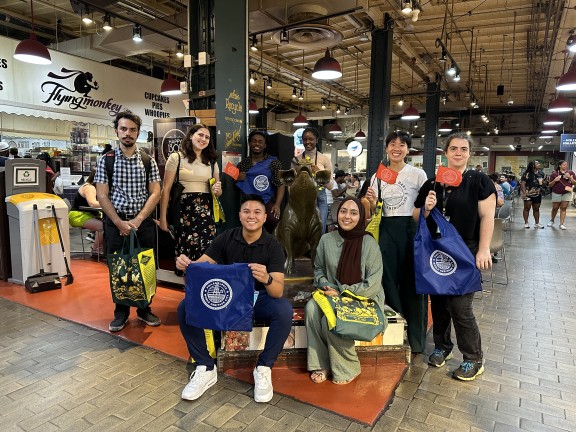From Fresh Produce to Prepared Foods: The Importance of Reading Terminal Market on Philadelphia's International Stage

On Wednesday, July 12th, the interns at Global Philadelphia Association got the opportunity to go to Reading Terminal Market and learn about its history, discover some fun facts, and taste delicious food with Layla El Tannir, Director of Business Development and GPA board member. The 130-year old market, located in a building that belongs to the state of Pennsylvania, offers everything from fresh produce to prepared meals, baked goods, and even linens and other non-food products. As a National Historic Landmark, it illustrates an important part of the heritage of Philadelphia and the US as a whole.
There is a wide variety of global cultures represented at Reading Terminal Market, not only in the cuisines present, but also in the diverse identities of the merchants. There are no chain restaurants in the market, and a lot of the merchants are families of various nationalities. An example Layla showed us was Luhv Vegan Deli, owned by an Argentinian family who takes inspiration from their home country's cuisine to craft vegan alternatives to deli offerings. They represent just how much thought is behind every food item at Reading Terminal.
Some of the other global-focused merchants highlighted during our tour were: El Merkury, who serves Guatemalan street food, A Taste of Spain, who sells both prepared dishes and groceries, all imported from Spain, The Head Nut, who offers nuts, candy, and other products from all over the world, and Olympia Gyro, a go-to spot for greek food.
During the tour, we were shown the growth and evolution of the market over the years. On some of the walls, the old stall numbers are still visible, and the current merchants occupy the space that used to accommodate about seven merchants. This growth means that Reading Terminal Market is able to welcome a large number of people. Annually, the market currently attracts five to six million visitors, both locals and tourists.
Another interesting aspect that was pointed out was the use of the neon signs. In the current global context, many neon signs are actually just LEDs, but most of those signs in the market are still authentic neon signs. This contributes to the overall character of Reading Terminal Market, not only in terms of the food, but also tradition.
At the end of the visit, the interns posed for a picture with Philbert the Pig, the market's mascot. It acts as a piggy bank whose donations are given to a different charity every month. This is yet another positive aspect of the market that contributes to its significance and attracts visitors from all over the world.
Overall, Reading Terminal Market is a hub where community and global cultures meet. Its importance as an NHL is due to both the food and historical relevance of the building, which has adapted to embody Philadelphia’s expanding international connections. It is a great place to visit on any occasion, and there is something for everyone!
